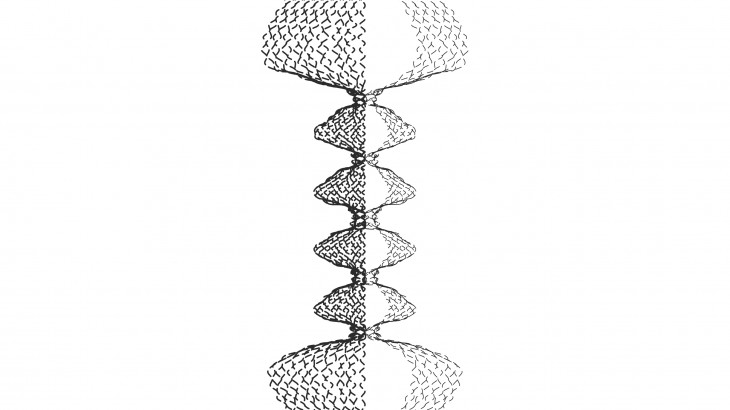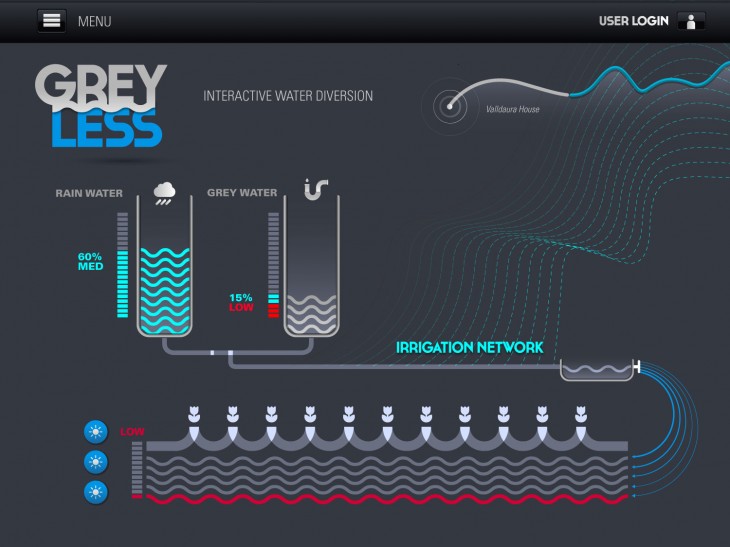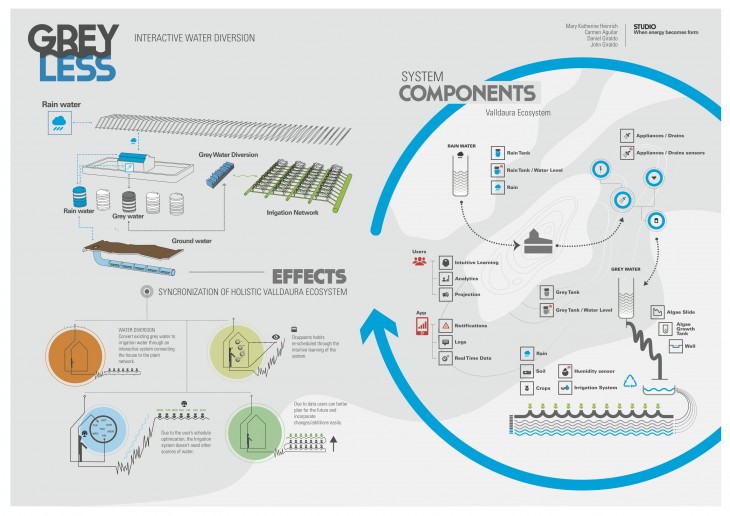Design Approach
An interactive water diversion system, linking Valldaura’s plants and residents to its grey water. The interactive system will, via the GreyLess App, allow users to make decisions based on real information of their plants soil humidity levels. The model will also be used as a screen to project live data on the soil conditions. Combining experiments, research, and lessons learned from previous prototypes, the GreyLess system is ready to clean grey water and turn it into irrigation water.
Prototype
The midterm Greyless prototype is a 1:1 object scaled phyto-depuration system ideal for low volumes of water. This is a formal version of a slow sand filter, maximizing surface area for future bio-film (algae) build up and aeration two things that are critical when cleaning water. The GreyLess system will communicate the needs of Valldaura’s plants using a wifi application available to residents and guests as well as creating energy.
The 4th prototype is made up of a high and low pool with a algae slide in between.
The high pool is a mixing and circulating pool. The high pool is attached to the algae tank where algae is exposed to light and photosynthesis allows it to grow. Once this water enters the high pool the algae-grey water slowly circulate and the mixture is evenly distributed as biofilms are deposited on the pools teeth, before flowing down the slide and into the settling pond.
The GreyLess system works similar to a sand filter, as water passes through the system it travels through various sized sand particles. This change in size of the sand particles as well as the change in water flow and pressure drove our design for the algae slide walls. The algae slide connects the two pools, accelerating water, creating turbulence while orthogonal tooth tessellations interrupt water flows creating more oxygenated water. Within the algae slide there are 4 flumes, these are oxygenating forms that boost water aeration as it flows through each pond. The flume form has been designed to mimic venturi tunnels, where pressure changes as water flows from higher speeds to lower speeds through constricted areas. The 4 flumes each have gradual water flow entrance and a sharp more orthagonal water flow exit with protruding teeth to break up the water vectors. The first flume’s teeth are exaggerated, heightened, and reed-like in order to catch debris before it goes through the rest of the slide and flows to the settling pool.
The settling pool is an essential step for cleaning water. The algae-water needs about 2 hours to separate before the now clean water can put into the irrigation system and the algae can be recycled back into the algae tank.
A Phytodepuration system cleans water. Hydroelectric generation is one of the “greenest” energy alternatives will create a more dynamic system. Using graphite, we installed 3 separate anodes and cathodes at different locations to produce energy as water flows through the system. These pairs protrude similar to the vector interrupting teeth as seen throughout the rest of the prototype. In the future the energy collected will be used to power a motor to mix algae within the algae tank.
Projection
A 2D animation will be projected on our GreyLess system showing a map of vectors representing the water flow through the slide. The projection will help the residents of Valldaura understand what is going on within the system. From the 2D animation the users will see: 1) The flow through the system, 2)Water Levels in the Grey and Rain water tanks, 3) Soil Humidity Levels; low water levels = agitated lines and 4) Water is present on slide. The users will be able to understand all of this information and view actual data using the application, but over time, they will also be able to understand the system using the projection.
Application
Connecting a phytodepuration system to Valldaura residents. First, water diversion: GreyLessconverts existing grey water to irrigation water through an interactive system connecting the house and its residents to the plant network. The app will facilitate the re-scheduling of occupants habits through learning about the system. Next, because of the re-allocation of grey water as well as the users schedule optimization, the irrigation system does not need exterior sources of water or water from rain water tanks. Through the use of this system, users can better plan for the future, not only can their actions can adjust due to the needs of the plant network, but changes and/or additions to the plan network can be incorporated easily.





